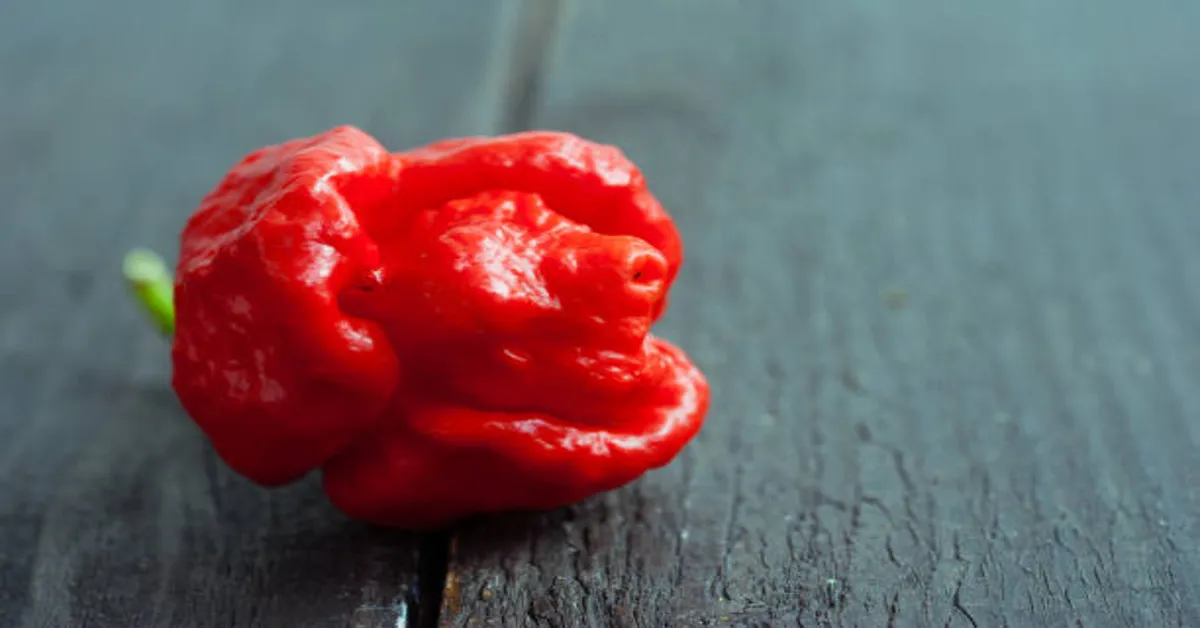The Carolina Reaper has earned its place in history as one of the hottest chili peppers ever recorded, recognized for its scorching heat and distinctive fruity flavor. This remarkable pepper is more than just a fiery challenge for spice lovers—it represents centuries of plant breeding, culinary innovation, and cultural fascination with the extremes of flavor and heat. In this article, we will dive deep into every aspect of the Carolina Reaper: its origins, cultivation methods, nutritional benefits, culinary applications, health considerations, and even its role in food science and popular culture.
Origins and History of the Carolina Reaper
The Carolina Reaper was developed in South Carolina, United States, by chili pepper breeder Ed Currie. Currie’s passion for peppers was not limited to creating heat for novelty; he also aimed to enhance the nutritional and health properties of peppers. By crossbreeding a Pakistani Naga pepper with a Red Habanero, he created a hybrid that took the chili world by storm.
In 2013, the Carolina Reaper was officially recognized by Guinness World Records as the hottest chili pepper in the world, averaging 1,641,183 Scoville Heat Units (SHU) with recorded peaks surpassing 2.2 million SHU. This level of intensity placed it far beyond common peppers like jalapeños (2,500–8,000 SHU) and even ghost peppers (Bhut Jolokia, around 1,000,000 SHU).
The Reaper’s name reflects both its fiery reputation and its striking appearance: a wrinkled, bumpy red pod with a distinctive pointed “tail” resembling a reaper’s scythe.
The Scoville Scale and Carolina Reaper Heat Levels
To understand the Carolina Reaper, one must appreciate the Scoville Heat Scale, which measures the concentration of capsaicin—the compound responsible for chili pepper heat.
Table: Heat Levels of Popular Chili Peppers
| Pepper Variety | Average SHU Range | Heat Comparison |
|---|---|---|
| Bell Pepper | 0 | No heat, sweet flavor |
| Jalapeño | 2,500 – 8,000 | Mild to medium |
| Cayenne | 30,000 – 50,000 | Noticeably hot |
| Thai Chili | 50,000 – 100,000 | Very hot |
| Habanero | 100,000 – 350,000 | Extremely hot |
| Ghost Pepper (Bhut) | 800,000 – 1,041,427 | Among the hottest globally before Reaper |
| Trinidad Scorpion | 1,200,000 – 2,000,000 | Fiery and aggressive |
| Carolina Reaper | 1,641,183 – 2,200,000+ | Officially hottest, with record-breaking peaks |
The Reaper’s heat comes on rapidly and lingers, often intensifying over minutes. This sustained burn is part of what makes it legendary among chili enthusiasts.
Cultivation and Growth Requirements
Growing the Carolina Reaper requires careful attention, as the plant thrives under specific conditions. It is not only a test of spice tolerance but also of gardening patience.
Climate and Soil Requirements
Carolina Reaper plants flourish in warm climates with temperatures between 70–95°F (21–35°C). They require well-drained soil with a pH between 6.0 and 6.8, rich in organic matter. Consistent moisture is important, but overwatering can cause root rot.
Sunlight
At least 6–8 hours of direct sunlight per day are needed for robust growth and fruit development. Indoor growers often use high-intensity grow lights to mimic natural conditions.
Planting and Harvesting
Seeds are typically started indoors 8–12 weeks before the last frost. Transplanting occurs once seedlings have grown strong roots and nighttime temperatures remain above 55°F (13°C). The plants can reach 4 feet in height and produce pods after 90–120 days.
Harvesting requires protective gear, as even handling the pods can cause skin irritation due to capsaicin oils. Ripe fruits are vibrant red with a glossy sheen and bumpy texture.
Flavor Profile Beyond the Heat
While many think of the Carolina Reaper Reaper purely in terms of fiery intensity, it also carries a surprisingly complex flavor. The initial taste is fruity, with notes of sweetness similar to cherries or citrus. This sweetness, however, is quickly overtaken by an overwhelming wave of heat that can persist for over 15 minutes.
Chefs and chili enthusiasts appreciate this unique combination, as it allows the Reaper to be used creatively in sauces, marinades, and salsas. The flavor complexity makes it more versatile than peppers that are just “hot without depth.”
Nutritional Value and Health Benefits
Beyond its reputation as a challenge pepper, the Carolina Reaper contains valuable nutrients that support overall health.
Nutritional Composition (per 100g fresh pepper)
- Calories: ~40 kcal
- Carbohydrates: ~9 g
- Protein: ~2 g
- Fat: ~0.5 g
- Fiber: ~1.5 g
- Vitamin C: 150–200 mg (more than double that of an orange)
- Vitamin A: 15% of daily requirement
- Capsaicin content: Extremely high, the primary bioactive compound
Health Benefits
- Antioxidant Properties: High vitamin C and carotenoids strengthen immunity and reduce oxidative stress.
- Metabolism Boost: Capsaicin has been linked to increased calorie burning and appetite regulation.
- Pain Relief: Topical creams use capsaicin to reduce nerve pain in conditions such as arthritis.
- Cardiovascular Support: Studies suggest capsaicin may improve blood circulation and reduce cholesterol levels.
- Mood Enhancement: Eating hot peppers releases endorphins, producing a “chili high.”
Risks and Safety Considerations
While the Carolina Reaper Reaper can be beneficial in small quantities, excessive consumption poses risks:
- Gastrointestinal Distress: Stomach cramps, nausea, and diarrhea can occur with overindulgence.
- Capsaicin Overload: Extremely high doses may cause burning in the throat, difficulty breathing, and temporary loss of taste.
- Skin and Eye Irritation: Handling peppers without gloves may result in burns or accidental transfer to eyes.
- Medical Contraindications: People with ulcers, acid reflux, or irritable bowel syndrome should avoid very hot peppers.
Responsible use, proper preparation, and moderation are key.
Culinary Applications of the Carolina Reaper
Despite its heat, the Carolina Reaper Reaper has found its way into kitchens worldwide. Its balance of fruitiness and fire makes it ideal for:
- Hot Sauces: The most common use, where small amounts deliver intense flavor.
- Salsas and Chutneys: Blended with fruits like mango or pineapple for sweet-spicy pairings.
- Powders and Flakes: Dried Reaper pods are ground into powders for sprinkling on dishes.
- Marinades and Rubs: Infusing meats and vegetables with smoky, spicy depth.
- Specialty Products: Chocolates, chips, and even craft beers use Carolina Reaper Reaper for novelty and intensity.
Carolina Reaper in Popular Culture
The Carolina Reaper Reaper has become a cultural phenomenon. Viral internet challenges—such as eating a whole pepper raw or consuming Reaper-infused snacks—have spread worldwide. While entertaining, these stunts have occasionally led to medical emergencies, underscoring the importance of handling the pepper with respect.
Additionally, food companies market limited-edition products featuring Reaper heat to attract adventurous eaters. It has also inspired competitive eating contests and culinary experiments in extreme spice cuisine.
Scientific Interest and Research Applications
Researchers study the Carolina Reaper Reaper for its unusually high capsaicin concentration. Potential applications include:
- Medical Use: Exploring capsaicin for cancer treatment, pain management, and anti-inflammatory therapies.
- Agricultural Breeding: Using its genetics to develop new pepper varieties with both heat and resilience.
- Food Preservation: Capsaicin has antimicrobial properties that may extend shelf life of foods.
The pepper represents a fascinating intersection of gastronomy, horticulture, and biomedical science.
Comparison with Other Super-Hot Peppers
While the Carolina Reaper Reaper currently holds its world record status, other contenders like the Trinidad Moruga Scorpion and Dragon’s Breath Pepper have vied for the title.
Table: Carolina Reaper vs. Other Super-Hot Peppers
| Pepper | SHU Range | Notable Traits |
|---|---|---|
| Carolina Reaper | 1,641,183 – 2,200,000+ | Fruity sweetness, record holder |
| Trinidad Moruga Scorpion | 1,200,000 – 2,000,000 | Earthy flavor, bumpy surface |
| 7 Pot Douglah | 923,000 – 1,853,936 | Chocolate-brown pod, smoky flavor |
| Dragon’s Breath | ~2,480,000 (unofficial) | Experimental, not widely grown or tested |
| Pepper X | Claimed 3,180,000+ SHU | Developed by Ed Currie, unverified record |
Tips for Growing Carolina Reapers at Home
For hobbyists, cultivating Reapers at home can be rewarding. Key tips include:
- Start Indoors Early: Seeds need warmth and patience to germinate.
- Transplant Carefully: Harden plants gradually to outdoor conditions.
- Fertilization: Balanced fertilizers encourage pod production.
- Pest Management: Aphids and spider mites may target the plant; organic insecticidal soap is useful.
- Harvesting: Wait for full ripeness for maximum heat and flavor.
Conclusion
The Carolina Reaper Reaper is more than just the hottest pepper—it is a marvel of agricultural innovation, a cultural icon, and a testament to humanity’s fascination with the extremes of taste. Its unique blend of fruity sweetness and searing heat has carved out a place in global cuisine, while its potential health benefits and scientific applications make it relevant beyond the kitchen.
Handled with care and respect, the Carolina Reaper Reaper can be appreciated not only for its fire but also for its flavor, nutrition, and role in advancing food science.
ALSO READ: Comprehensive Guide to N Train Stops and Routes
Frequently Asked Questions (FAQs)
1. How hot is the Carolina Reaper compared to a jalapeño?
The Carolina Reaper can be over 400 times hotter than a jalapeño, with peak heat levels above 2.2 million SHU.
2. Can eating a Carolina Reaper be dangerous?
While not typically life-threatening, eating large amounts can cause severe discomfort, vomiting, and even medical visits for sensitive individuals.
3. What does the Carolina Reaper taste like besides being hot?
It has a surprising fruity flavor with hints of sweetness, followed by an intense and long-lasting burn.
4. Can I grow Carolina Reapers at home?
Yes, with proper care. They need warm conditions, well-drained soil, and plenty of sunlight to thrive.
5. Are there peppers hotter than the Carolina Reaper?
Some peppers like Pepper X and Dragon’s Breath claim higher heat, but they are not officially verified by Guinness World Records.









